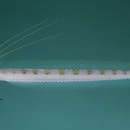Diagnostic Description
provided by Fishbase
Identified by the long filaments on the dorsal fin of the male (Ref. 48636). Body scaleless above and below lateral line on anterior half (Ref 12934).
- Recorder
- Grace Tolentino Pablico
Morphology
provided by Fishbase
Dorsal spines (total): 3; Dorsal soft rays (total): 43 - 45; Analspines: 1; Analsoft rays: 39 - 42
- Recorder
- Grace Tolentino Pablico
Trophic Strategy
provided by Fishbase
Inhabits sandy expanses of clear lagoon and seaward reefs.
- Recorder
- Grace Tolentino Pablico
Biology
provided by Fishbase
Found in coastal reef slopes and deep outer reef lagoons in current channels. Usually in large groups with several large males (Ref. 48636). Inhabits sand-rubble bottoms (Ref. 90102). Found hovering above sandy slopes. Usually forms a harem of one male-phase fish and about a dozen female-phase fish (Ref. 37240). Normally buried when no current is running (Ref. 48636).
- Recorder
- Cristina V. Garilao
分布
provided by The Fish Database of Taiwan
分布於西印度-
西太平洋區,包括馬爾地夫、印尼到斐濟,北至琉球群島,南至珊湖海。台灣分布於北部。
利用
provided by The Fish Database of Taiwan
小型魚,可供作觀賞魚,或作學術研究。
描述
provided by The Fish Database of Taiwan
體特別延長,纖細,略為側扁。兩眼間距短。口大,端位,吻能伸縮,下頜先端尖突;上頜骨不顯露。上下頜、腭骨及鋤骨上均有小而尖的齒列。鰓膜在喉峽部游離。體體被小圓鱗,頭部、頰部、鰓蓋部及側線前半部之上、下面則近於裸出。背鰭單一,起點在胸鰭起點之後,基底甚長,具III弱棘,軟條數43-45,雄性魚的前方弱棘延長成游離狀;臀鰭和背鰭相對,硬棘I,軟條39-42;腹鰭發育良好,具I硬棘,5軟條;尾鰭呈尖形(雄魚)或截形(雌魚)。體灰白色,體背側具黃褐色鞍狀斑;頭部、體側及各鰭另具白色至藍色點。背鰭硬棘鰭膜黑色。
棲地
provided by The Fish Database of Taiwan
主要棲息於礁區斜坡以及潟湖外圍較深礁石區。通常發現在沙底的斜坡上面盤旋。一夫多妻制,通常會形成一隻雄成魚帶領大約十二隻雌性魚的魚群。
Trichonotus elegans
provided by wikipedia EN
Trichonotus elegans, the long-rayed sand-diver, is a species of marine perciform fishes. It is found throughout the Indo-West Pacific.[3] This species occurs in coastal reef slopes and deep outer reef lagoons where the channels create currents. It is a sociable species which is found in large groups each including a number of larger males. Its preferred habitat is substrates made up of sand and coral rubble). It is normally seen sitting still in the water column above sandy slopes. Their social grouping normally consist of a single male and a harem of around twelve females. Species in the genus Trichonotus are protogynous hermaphrodites.[4] They are usually buried when the current is slack.[1]
References
-
^ a b Carpenter, K.E. & Smith-Vaniz, W.F. (2017) [errata version of 2016 assessment]. "Trichonotus elegans". IUCN Red List of Threatened Species. 2016: e.T69739558A115472765. doi:10.2305/IUCN.UK.2016-3.RLTS.T69739558A69742679.en.
-
^ Shimada, K. and T. Yoshino, 1984. A new trichonotid fish from the Yaeyama Islands, Okinawa Prefecture, Japan. Jap. J. Ichthyol. 31(1), pages 15-22
-
^ Froese, Rainer; Pauly, Daniel (eds.) (2018). "Trichonotus elegans" in FishBase. February 2018 version.
-
^ Kusen, J.D.; Nakagawa, K.; Yogo, Y. & Nakazono, A. (1991). "Protogynous hermaphroditism in the sand diver Trichonotus filamentosus". Nippon Suisan Gakkaishi. 57 (1): 35–40. doi:10.2331/suisan.57.35.

- license
- cc-by-sa-3.0
- copyright
- Wikipedia authors and editors
Trichonotus elegans: Brief Summary
provided by wikipedia EN
Trichonotus elegans, the long-rayed sand-diver, is a species of marine perciform fishes. It is found throughout the Indo-West Pacific. This species occurs in coastal reef slopes and deep outer reef lagoons where the channels create currents. It is a sociable species which is found in large groups each including a number of larger males. Its preferred habitat is substrates made up of sand and coral rubble). It is normally seen sitting still in the water column above sandy slopes. Their social grouping normally consist of a single male and a harem of around twelve females. Species in the genus Trichonotus are protogynous hermaphrodites. They are usually buried when the current is slack.
- license
- cc-by-sa-3.0
- copyright
- Wikipedia authors and editors

